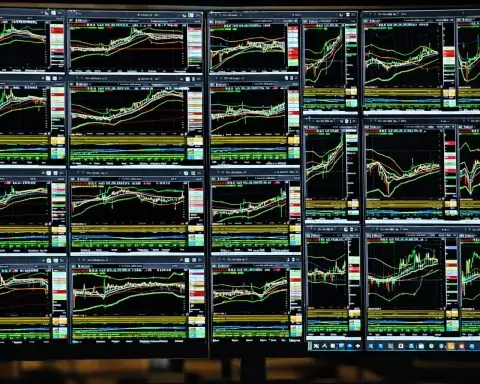Dow Jones pulls back from a fresh record above 48,000 as Wall Street digests the end of the longest U.S. government shutdown, a sharp Disney sell-off, and renewed pressure on Big Tech.
Market overview: Wall Street takes a breather after record highs
U.S. stocks traded lower on Thursday, November 13, 2025, as investors pivoted from celebrating fresh records to worrying about what comes next for the economy and interest rates.
By early trading, the major indexes were down across the board:
- Dow Jones Industrial Average: off about 0.2% around 48,168, retreating from Wednesday’s first-ever close above the 48,000 mark. [1]
- S&P 500: down roughly 0.5% near 6,815. [2]
- Nasdaq Composite: weaker still, down about 0.9% around 23,192, as growth and AI names continued to slide. [3]
The pullback comes just one day after the Dow jumped more than 300 points to close around 48,254, its first finish above 48,000, powered by financials and optimism that Washington was close to reopening the federal government. [4]
That optimism turned into a reality — and then into a headache.
Government shutdown ends, but data fog and Fed doubts hit sentiment
Late Wednesday, President Donald Trump signed a funding bill that ended the record 43‑day federal government shutdown, keeping agencies funded into late January. [5]
The reopening is a relief for:
- Federal workers, who had missed multiple paychecks
- Families dependent on food benefits, whose support had been delayed
- Investors and the Federal Reserve, who can finally start getting official data again after weeks of being forced to rely on private estimates [6]
But the shutdown’s legacy is messy:
- Some October reports, including jobs and inflation data, may never be released at all, leaving scars in the economic data series. [7]
- The Fed’s December rate-cut odds have been marked down; traders now price only about a 50–55% chance of a quarter‑point cut, down from roughly 70% a week ago. [8]
Bond and currency markets show the shift in tone:
- The 10‑year Treasury yield has crept up to around 4.10–4.11%, from just over 4.07% at Wednesday’s close. [9]
- The U.S. dollar index (DXY) has slipped to roughly 99.1, down about 0.3–0.4%, as investors re‑evaluate how aggressive the Fed will be. [10]
- The CBOE Volatility Index (VIX) jumped into the high‑teens to around 19, after opening near 17.6, signaling a clear uptick in “fear premium” compared with October. [11]
In short: the shutdown is over, but its economic fog and policy uncertainty are very much alive — and today’s selling reflects that.
Disney stock plunges after mixed Q4: biggest drag on the Dow
If the macro backdrop is the stage, Walt Disney Co. (DIS) is today’s main character — and it’s playing the villain for the Dow.
Disney’s fiscal Q4 2025 report delivered a classic “good EPS, bad revenue” combo:
- Revenue: about $22.5 billion, slightly below expectations near $22.7 billion and down a touch year‑over‑year. [12]
- Adjusted EPS: roughly $1.11 per share, a small annual decline but ahead of Wall Street forecasts. [13]
Under the hood, the story is increasingly two‑speed:
- Streaming & parks: growing and profitable
- Direct‑to‑consumer revenue (Disney+, Hulu, ESPN+) rose about 8% to $6.25 billion. [14]
- Disney+ ended the quarter with around 132 million subscribers, and combined Disney+ + Hulu subs hit roughly 196 million, both ahead of forecasts. [15]
- Parks, cruises, and experiences remained a bright spot, supported by strong demand and expansion initiatives. [16]
- Linear TV & traditional media: still bleeding
- Domestic network revenue fell about 16%, and operating income dropped over 20%, as cord‑cutting and weaker advertising continued to bite. [17]
On top of that fundamental pressure, Disney warned that its distribution fight with YouTube TV — which has kept Disney networks off a service with roughly 10 million subscribers since October 30 — could drag on. Management said it has already baked a potentially lengthy blackout into guidance, and one analyst estimate suggests a two‑week outage alone could cost Disney about $60 million. [18]
Wall Street’s reaction was brutal:
- Disney shares plunged roughly 8–9% in early trading, falling more than $10 per share. [19]
- According to MarketWatch’s Dow data, Disney and Nvidia together accounted for roughly 113 points of downside, helping drive a 331‑point (0.7%) morning drop in the Dow. [20]
For the Dow, which is price‑weighted, a double‑digit dollar slide in a single heavyweight like Disney hits far harder than it would in a market‑cap‑weighted index.
Big Tech and AI names drag the Nasdaq lower
Today’s weakness isn’t just about Disney. Technology and communication services stocks are once again the biggest anchors on the market.
- Reuters reports that Nvidia and Alphabet were down about 2–3% in early trade, leading sector losses on the S&P 500. [21]
- Investopedia’s live coverage noted that the Nasdaq opened down roughly 1.7%, with high‑beta names like Tesla, Palantir, and Arm falling around 5%, while AppLovin, Shopify, and Broadcom slid more than 4%. [22]
Some bright spots still exist in tech:
- Cisco Systems jumped around 4–4.5% after raising its full‑year profit and revenue outlook on stronger networking demand. [23]
But overall, the message is clear: after a multi‑month AI‑driven melt‑up, investors are rotating out of expensive growth stocks into more defensive or value‑oriented names, including healthcare and big banks. [24]
Nike and IBM: earlier Dow drags frame the week’s volatility
Today’s Disney‑led drop comes on the heels of earlier pressure from other Dow stalwarts.
On Friday, November 7, the Dow was down about 162 points (0.3%) in afternoon trading as Nike and IBM delivered the biggest hit to the price‑weighted index:
- Nike (NKE) fell roughly $1.45 (about 2.3%).
- IBM (IBM) dropped around $6.99 (about 2.2%).
- Together, those two moves alone accounted for about 52 points of the Dow’s decline, according to Dow Jones data. [25]
Goldman Sachs, Nvidia, and Boeing also contributed to that drop, underlining how concentrated single‑stock moves can shape the day’s narrative when the Dow is this high. [26]
A choppy November: from broad selloff to record highs to another pullback
Zooming out, November has been a whiplash month for equities:
- On November 6, U.S. stocks closed lower as consumer services, technology, and consumer goods names sold off. The Dow fell 0.55%, the S&P 500 0.76%, and the Nasdaq 1.43%, with losers including Salesforce, Nvidia, McDonald’s and CarMax, while the VIX jumped, signaling rising nerves. [27]
- On November 7, Nike and IBM led another leg down for the Dow, as noted above. [28]
- By November 12, the mood flipped: the Dow surged above 48,000 for the first time, notching one more record close on optimism that the shutdown would finally end, while banks, airlines, and other cyclicals rallied. [29]
- Today, November 13, the tone is cautious again as investors digest the shutdown’s economic damage, softer Disney revenue, and renewed pressure on Big Tech, pushing the major indexes lower despite Wednesday’s high-water mark. [30]
Underneath the headline moves, interest‑rate expectations, missing data, and corporate earnings surprises are all colliding — a classic recipe for short‑term volatility.
What today’s moves mean for investors
For traders and long‑term investors alike, November 13 is less about a single down day and more about what the market is trying to price in.
1. Expect more “data‑driven” whipsaws
With key economic reports delayed or partially missing due to the shutdown, each new data point and Fed speech might carry outsized impact in the coming weeks. Markets are now balancing:
- Slower, foggier data
- A Fed that seems less certain about cutting in December
- Earnings that increasingly reward durable cash flows and punish over‑promises [31]
2. Sector rotation is very real
Recent action highlights a rotation away from the most crowded AI and growth trades and toward:
- Financials and dividend payers, which helped lift the Dow to its recent record [32]
- Select value and defensive sectors such as healthcare and consumer staples [33]
That doesn’t kill the AI story, but it does mean valuations and earnings delivery now matter more than the buzz.
3. Disney is a case study in “mixed” earnings
Disney’s quarter shows how headline EPS beats are no longer enough when:
- Revenue misses expectations
- Legacy businesses like linear TV are shrinking fast
- Strategic disputes (like the YouTube TV blackout) threaten future cash flows [34]
Investors will be watching whether streaming growth and parks strength can offset declining traditional media over the next few quarters.
4. Risk management matters more than headlines
For individual portfolios, days like today are a reminder to:
- Avoid making big decisions based on one session’s news
- Check position sizing in volatile names (especially high‑beta tech and single‑stock AI plays)
- Ensure diversification across sectors, styles, and geographies
As always, any strategy should match your time horizon, risk tolerance, and financial goals. This article is informational only and not personalized investment advice.
Stay tuned: with the government back open, crucial employment, inflation, and spending data will start to trickle out again — and in a market already on edge, each number could be the next catalyst.
References
1. www.reuters.com, 2. www.reuters.com, 3. www.reuters.com, 4. www.wsj.com, 5. www.investopedia.com, 6. www.investopedia.com, 7. www.reuters.com, 8. www.reuters.com, 9. www.investopedia.com, 10. tradingeconomics.com, 11. www.investing.com, 12. www.investopedia.com, 13. www.investopedia.com, 14. www.investopedia.com, 15. www.investopedia.com, 16. www.reuters.com, 17. www.investopedia.com, 18. www.reuters.com, 19. www.marketwatch.com, 20. www.marketwatch.com, 21. www.reuters.com, 22. www.investopedia.com, 23. www.reuters.com, 24. www.reuters.com, 25. www.itiger.com, 26. www.itiger.com, 27. www.investing.com, 28. www.itiger.com, 29. www.wsj.com, 30. www.reuters.com, 31. www.reuters.com, 32. www.wsj.com, 33. www.reuters.com, 34. www.investopedia.com









